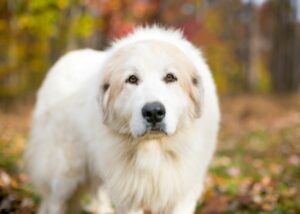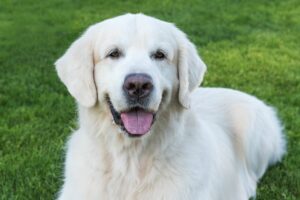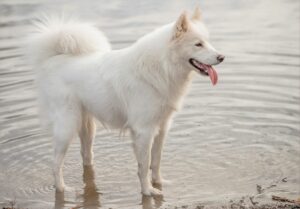The Saint Bernard is a big dog with a big heart. It is a gentle dog that fits perfectly in a family with children. In the past, the Saint Bernard was known as a rescue dog that helped people who were snowed in under in the Alps. An impressive feat from this hard-working dog breed. Nowadays, the Saint Bernard enjoys working for his family.
Maybe you know this breed from the movie Beethoven, in which this dog breed plays the lead role. Do you want to know more about the Saint Bernard and are you wondering if this breed is right for you? Then read this article.
The history: a rescue dog from the Alps
The Saint Bernard originally comes from Switzerland and Italy. Around the year 1050, a monk named Bernhard of Menthon lived there. He founded a monastery and a hospice for through travelers on a high mountain pass between Switzerland and Italy. This was an important stopover and refuge for pilgrims on their way to Rome. This path is also known as the Great St. Bernard Pass.
It was a dangerous route and it happened that travelers disappeared or ended up under the snow. It is known that large mountain dogs were kept in that area for surveillance and protection. The main task for the Saint Bernard dogs was to track down lost and perished travelers. The dogs worked together with the monks of the monastery. If the Saint Bernard found someone, he tried to bring him or her back to the monastery.
If this was too difficult, he would get help from the monks. Several dogs also worked together. One dog stayed with the victim and the other went back to get help. They worked together as a real rescue team. The Saint Bernard was recognized as a Swiss breed in 1885 and has been the national dog of Switzerland since then.
The character: playful, inquisitive and friendly
The Saint Bernard is naturally friendly and confident. The temperament can vary from dog to dog from quiet to lively and playful, but in general the Saint Bernard is quite calm. It is a good watchdog; he is eager to protect his owner and his family. He loves to get a lot of attention and love. The Saint Bernard gets along particularly well with children and most of them get along well with other pets as well. He would like to be a part of the family and will do anything to please his owner.

The appearance of a Saint Bernard
The Saint Bernard is a large dog and has an imposing, powerful and muscular appearance. The height at the withers of a male dog is 70 to 90 cm. The height at the withers of a female is 65 to 80 cm. A Saint Bernard can weigh 64 to 120 pounds.
There are two different types of this breed, the shorthaired and the longhaired. In general, most have a short coat, but certain crossings have also created longhaired Saint Bernard’s. The ground color of the coat is white with small or large reddish-brown spots over its body. Sometimes there can also be black in the coat.
In proportion, the Saint Bernard has a large head and a broad neck. The ears are worn down and he has a short snout with a square shape. The eyes are not very large and the color varies from dark brown to hazelnut brown. In many cases, the Saint Bernard has a friendly facial expression. The body is completely straight and muscular making the dog an imposing presence. He has a long heavy tail that is carried downward.
The care
The eyes and ears of a Saint Bernard are sensitive and therefore it is important to clean them regularly to prevent irritation and inflammation. Cleaning can be done with water. Occasionally a bath keeps the Saint Bernard fresh and clean. Use special dog shampoo for this.
As with all dog breeds, it is wise to regularly check the nails and trim them if necessary. If the nails are too long then this can cause problems during movement. Long nails are painful for dogs.
The coat of a Saint Bernard varies in longhaired and shorthaired. Both coats need the same care. Brush the dog weekly to remove dirt and loose hair. While doing this, make sure to remove tangles as well. Twice a year the Saint Bernard loses more hair. In this period it is important to brush the dog daily.
Besides this external care, it is also important to let the Saint Bernard exercise sufficiently. Daily walks are often sufficient. A Saint Bernard also likes long walks in the woods.

Are there diseases that occur in this breed?
A Saint Bernard is a large breed that reaches an average age of 8 to 10 years. They have an increased risk of the following hereditary diseases:
- Bone cancer
- Elbow dysplasia
- Hip dysplasia
- Inwardly curling eyelids
Elbow and hip dysplasia are common in larger breeds. This is a skeletal disorder that can make the joints less flexible. This can occur in a young dog, but it can also develop later in life in combination with osteoarthritis. It is important that your Saint Bernard is under control at the vet. He will keep an eye on it and possibly start a treatment. Sufficient exercise, a healthy weight and the right diet can reduce the risk of dysplasia. Food for larger dog breeds often contains glucosamine. This is a supplement for supple joints.
Did you know?
The Saint Bernard is known from the 1992 movie Beethoven. The movie is about two thieves who stole a group of puppies from a pet store. One of those puppies is a Saint Bernard. The movie is about the adventures of this mischievous, but sweet Saint Bernard dog. Since the movie, the breed is often called Beethoven in homage to the movie.
Dog training for this breed
A Saint Bernard is suitable for training. Dog training is especially recommended for this breed to teach a Saint Bernard what is socially desirable. He will learn not to jump on people or tables, steal food or jump up against children. Because it is such a large dog it can be very annoying and heavy when he jumps up against you, so you want to unlearn this as soon as possible. A Saint Bernard is very smart and eager to learn. Calm and gentle training works best for this breed.
A Saint Bernard likes to be with his family and will therefore also want to be obedient. He does need a clear and consistent education. If this does not happen he can become stubborn and invent his own rules.
In addition, puppy training is advised for every breed of dog. This is important to build a strong bond between the dog and his owner and to learn to obey. It is also useful to teach your dog the basic commands such as sit and lie down. During puppy training they will help you with this. When your dog is eight to ten weeks old, you can start with puppy training.

What does a Saint Bernard cost?
For a pup with a normal pedigree you pay between $1400 and $2400 at a less known breeder. At a well-known breeder you will pay between $2400 and $4700 for a puppy with a premium pedigree. These are then allegedly excellent quality puppies. If you want a pup without a pedigree you pay between $800 and $1400.
Compared to other dog breeds you pay on average a little more for a Saint Bernard. The prices can vary greatly by breeder. If you find a Saint Bernard for a price much lower than the amounts above, then you must ask yourself if you are perhaps dealing with a bread breeder. Always do good research on where you are getting your puppy.
In addition to purchase costs, you must also consider maintenance costs. These include costs for food, dog toys, a basket, a leash, vet fees and dog tax. Because a Saint Bernard is a large dog, it needs more food than smaller breeds. Therefore, the cost of food can add up quickly. Think before you buy a puppy if you are willing to pay these costs and if you can afford it yourself. After all, good care is very important for the health of a Saint Bernard.
How much exercise does this breed need?
Despite being a large dog, a Saint Bernard does not need as much exercise compared to other large dog breeds. A Saint Bernard has enough with the daily walks and a play session of half an hour. Do you like to go out and about or take a long walk in nature? Then you have come to the right place with a Saint Bernard. Even though he does not need a lot of exercise, he is happy to undertake activities together with his owner. He loves to go on adventures. Please note that a Saint Bernard, due to its large size, is prone to injuries.
Recognition in the US
The AKC officially recognized the Saint Bernard as a breed in 1885. This means that it is a healthy dog breed that may be bred with and that can participate in various sporting events. There is also a breed club for the Saint Bernard that is recognized by the AKC, namely The Saint Bernard Club of America. This association is concerned with maintaining a healthy breed and organizing various events for the Saint Bernard.

Do you already have a Saint Bernard or are you planning to purchase one?
The Saint Bernard is a hard worker who used to rescue people in the Alps. This is an impressive achievement. Nowadays, this dog also fits perfectly in a family. The Saint Bernard loves to do activities with his owner and will also like to guard and protect his family. Temperament can vary from dog to dog, but in general every Saint Bernard is very friendly. Do you currently own a Saint Bernard or are you planning to purchase one? Share your experiences below in the comments.







